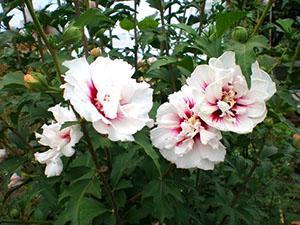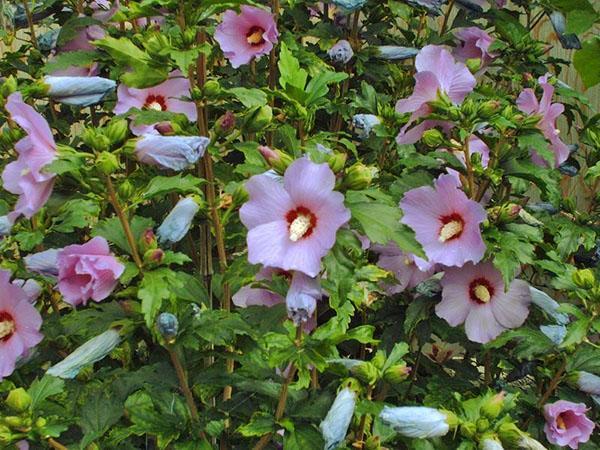Care and reproduction of garden hibiscus
 The tropics have presented many plants for cultivated agriculture. Among them hibiscus garden, care and reproduction will not cause difficulties even in the middle lane. Among the many garden varieties, the most unpretentious is the Syrian hibiscus. It endures low temperatures and moves further north.
The tropics have presented many plants for cultivated agriculture. Among them hibiscus garden, care and reproduction will not cause difficulties even in the middle lane. Among the many garden varieties, the most unpretentious is the Syrian hibiscus. It endures low temperatures and moves further north.
Hibiscus garden plant and its varieties

- herbaceous varieties;
- tree-like;
- shrubby.
Growing and caring for garden hibiscus is a fun experience. IN landscape design all plant species occupy special niches. Herbaceous varieties overwinter well under cover and produce beautiful curtains that mask household structures.
Read also the article: chinese rose home care and pruning!
 Planting and care of garden hibiscus - photo - shrub, allows you to get a hedge and various compositions by formation. It is especially easy to work with the unpretentious Syrian hibiscus. It is the shrub that has become the most common in the mild climate of the middle zone. It is easier to cover for winter preservation.
Planting and care of garden hibiscus - photo - shrub, allows you to get a hedge and various compositions by formation. It is especially easy to work with the unpretentious Syrian hibiscus. It is the shrub that has become the most common in the mild climate of the middle zone. It is easier to cover for winter preservation.
Hibiscus agricultural technology
 To grow garden hibiscus in an unusual climate, the recommendations of breeders must be followed in care and reproduction. The main operations are:
To grow garden hibiscus in an unusual climate, the recommendations of breeders must be followed in care and reproduction. The main operations are:
- choose a planting site;
- water and feed;
- prepare for wintering.
Care includes protecting plantings from pests, diseases and creating decorative forms.
In a bright, sunny place and without transplanting, garden hibiscus can grow up to 20 years. The selected location should be protected from wind and scorching sunlight. Planting a plant from a container or transplanting should be carried out in the spring, when the plant is full of vitality. Well-developed plants are planted with seedlings. Basically, bushes that have overwintered in a container in a warm place are transplanted.
Proper rooting of hibiscus
The strong root system of the plant consists of a central shaft with tines. A hibiscus transplant is unnecessary if it is getting enough nutrition. Therefore, the landing pit is prepared in advance. It is dug out with a margin so that the roots have a place for development at first in loose soil. The nutritional composition is laid down:
- turf land - 2 parts;
- leafy land - 2 parts;
- ripe humus - 1 part;
- coarse sand - 1 part.
Pour half a bucket of water. Roots are arranged on the pillow, without damage, with the expectation that the upper tier will be at surface level. Only light roots work on the plant, the old ones take nutrients for themselves.
 The soil is carefully poured and compacted, and the new plant is spud and watered on top so that the earth between the roots is compacted. In the photo, planting and subsequent care of the tree hibiscus.
The soil is carefully poured and compacted, and the new plant is spud and watered on top so that the earth between the roots is compacted. In the photo, planting and subsequent care of the tree hibiscus.
If the plant needs to be transplanted to a new location, then the best time in spring is before flowering. At the same time, the upper roots are removed, and the tree is moved to a new place without destroying the earthy coma. So that the plant can feed the upper part, the crown is trimmed before transplanting.
Regular feeding is important in the cultivation and care of garden hibiscus. phosphorus - potassium fertilizers... Phosphorus activates flowering, and potassium improves the winter hardiness of the plant. Juice with a high content of potassium salts does not like aphids - the main pest of the plant.
Formation of an ornamental plant
 In some areas with cold winters, garden hibiscus is grown as a tub plant. If three plants with different colors are grown in one container, then by intertwining the trunks in the process of growth, you can get a multi-colored composition with a common trunk, as in the photo of the garden tree hibiscus.
In some areas with cold winters, garden hibiscus is grown as a tub plant. If three plants with different colors are grown in one container, then by intertwining the trunks in the process of growth, you can get a multi-colored composition with a common trunk, as in the photo of the garden tree hibiscus.
 In the spring, with the appearance of new stems, the old dry twigs are removed. Pruning is necessary, only young branches bloom. Therefore, remove excess twigs before the start of sap flow in the spring. Old branches are cut out, the shoots of the last year are shortened by a quarter. Bushes can be given the desired shape by systematic pruning. There are several types of trimming:
In the spring, with the appearance of new stems, the old dry twigs are removed. Pruning is necessary, only young branches bloom. Therefore, remove excess twigs before the start of sap flow in the spring. Old branches are cut out, the shoots of the last year are shortened by a quarter. Bushes can be given the desired shape by systematic pruning. There are several types of trimming:
- stimulating, in early spring;
- thinning, removal of dried, weakened shoots;
- corrective;
- autumn, after the cessation of flowering;
- for survival when leaving a minimum of ground mass.
Watering and spraying hibiscus
 Water for irrigation needs rain or river water with low hardness. Watering the plant requires moderate, depending on the drying of the topsoil. If it's hot outside, watering can be done daily. The leaves must be washed from dust and thereby prevent the appearance of a spider mite. If the color begins to fall off en masse, there is not enough moisture. Chlorosis warns of watering with water with chlorine or iron. There is no violation if a beautiful flower falls off in a day. Another should bloom to replace it. A signal of danger is the massive fall of flowers and unopened buds. And most often the cause of the disease of hibiscus garden is improper watering.
Water for irrigation needs rain or river water with low hardness. Watering the plant requires moderate, depending on the drying of the topsoil. If it's hot outside, watering can be done daily. The leaves must be washed from dust and thereby prevent the appearance of a spider mite. If the color begins to fall off en masse, there is not enough moisture. Chlorosis warns of watering with water with chlorine or iron. There is no violation if a beautiful flower falls off in a day. Another should bloom to replace it. A signal of danger is the massive fall of flowers and unopened buds. And most often the cause of the disease of hibiscus garden is improper watering.
To save it from aphids, the plant must be sprayed with water and ash from cigars or cigarettes. Aphids cannot stand the smell of lavender growing next to hibiscus. Therefore, measures should be taken in advance so that the delicate leaves of hibiscus do not interest the insect.
Preparation for wintering is a crucial stage
The garden tree hibiscus sheds its leaves for the winter. In the middle lane, it grows no more than two meters. Hibiscus blooms from July until the first frost. The varieties that do not freeze out during the mild southern winter are considered frost-resistant. In the middle lane, shelter for tropical plants is necessary. For cultivation here, varieties with simple non-double flowers should be used.
In winter, the plant is watered abundantly, after the top layer has dried, it is spud high, but sand is added to the ground by a third. When stable frosty weather is established, the plant is covered with shavings, sawdust, dry foliage - a loose bedding about 15 cm high.
 The branches, as far as possible, bend to the ground, are covered with dense non-woven material in several rows. A frame is built on top, on which insulating materials and coniferous spruce branches are subsequently thrown. The photo shows how the garden hibiscus hibernates in the garden.
The branches, as far as possible, bend to the ground, are covered with dense non-woven material in several rows. A frame is built on top, on which insulating materials and coniferous spruce branches are subsequently thrown. The photo shows how the garden hibiscus hibernates in the garden.
 In temperate latitudes, tree-like hibiscus can winter only with warmed roots, but it is necessary to prepare a frame for rescue in extreme conditions. In areas with a continental climate, garden hibiscus is guaranteed to be kept in cellars by digging out a plant with a large clod of earth.
In temperate latitudes, tree-like hibiscus can winter only with warmed roots, but it is necessary to prepare a frame for rescue in extreme conditions. In areas with a continental climate, garden hibiscus is guaranteed to be kept in cellars by digging out a plant with a large clod of earth.
Herbaceous hibiscus will overwinter if it is insulated after the ground part has died.
Reproduction of garden hibiscus
 Hibiscus propagates easily by cuttings and seeds. Both methods are used, but cuttings give a decorative bush faster. The seed method allows you to get an adult flowering plant in 3 years.
Hibiscus propagates easily by cuttings and seeds. Both methods are used, but cuttings give a decorative bush faster. The seed method allows you to get an adult flowering plant in 3 years.
For cuttings, lignified cut shoots are suitable, which give a panicle of roots in water. The best cuttings can be planted in pots and planted in a permanent place after winter. You can also root cuttings in the substrate.But a strong bush that has grown stronger over the summer, ready for wintering, is obtained from an overwintered and grown seedling.